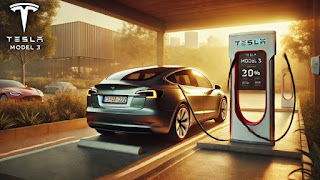Tesla Model 3 is one of the most popular electric vehicles (EVs) globally, known for its efficiency, cutting-edge technology, and impressive range. However, potential and current owners often wonder about the cost of charging a Tesla Model 3. Understanding the factors influencing charging costs can help you optimize expenses and maximize savings.
This article provides a detailed breakdown of Tesla Model 3 charging costs, covering home charging, public charging, Superchargers, and cost-saving tips. We also answer frequently asked questions to give you a complete guide to Tesla Model 3 charging expenses.
Factors Affecting Tesla Model 3 Charging Cost
1. Electricity Rates
Electricity prices vary depending on location, provider, and time of use. Peak hours usually have higher rates, while off-peak hours can offer lower rates.
2. Charging Method
The cost depends on whether you charge at home, a public charging station, or a Tesla Supercharger. Each method has different pricing structures.
3. Battery Size and Range
Tesla Model 3 comes in different battery versions:
Standard Range Plus (~272 miles per charge)
Long Range (~358 miles per charge)
Performance (~315 miles per charge)
The more battery capacity, the more electricity is required to charge fully.
4. Charging Efficiency
Not all the electricity consumed reaches the battery. Some energy is lost during charging, affecting overall costs.
Tesla Model 3 Home Charging Cost
1. Cost Calculation Formula
To estimate home charging costs, use this formula: Cost = Battery Capacity (kWh) × Electricity Rate ($/kWh)
Example:
Tesla Model 3 Standard Range Plus: 54 kWh battery
Electricity rate: $0.13 per kWh
Charging cost: 54 × 0.13 = $7.02 per full charge
2. Charging Time and Speed
Level 1 (120V): Slow, adds 3-5 miles per hour
Level 2 (240V): Faster, adds 25-30 miles per hour
Tesla Wall Connector: Even faster, up to 44 miles per hour
3. Off-Peak Charging for Savings
Many utility companies offer lower rates at night. Charging during these hours can reduce costs.
Public Charging Cost for Tesla Model 3
1. Cost Varies by Provider
ChargePoint: $0.20-$0.30 per kWh
EVgo: $0.30-$0.35 per kWh
Electrify America: $0.31 per kWh
2. Subscription Plans and Discounts
Some providers offer membership plans that reduce per kWh costs.
Tesla Supercharger Cost
1. Pricing Structure
Tesla Superchargers typically cost between $0.25 and $0.50 per kWh, varying by location.
2. Free Supercharging Credits
Some Tesla purchases come with free Supercharging credits.
3. Time-Based Fees
Some locations charge per minute rather than per kWh, depending on station congestion.
Charging Cost Comparison: Home vs. Public vs. Supercharger
| Charging Type | Cost per kWh | Full Charge Cost |
|---|---|---|
| Home Charging | $0.13 | ~$7.02 |
| Public Stations | $0.30 | ~$16.20 |
| Supercharger | $0.25-$0.50 | ~$13.50 - $27.00 |
10 Cost-Saving Tips for Tesla Model 3 Charging
Charge at home during off-peak hours
Use solar panels for home charging
Take advantage of free charging at workplaces or public stations
Monitor electricity rate plans for EV discounts
Use regenerative braking to extend range
Plan routes with free or low-cost chargers
Maintain battery health to improve efficiency
Use Tesla’s trip planner to optimize energy use
Avoid excessive Supercharger use to reduce costs
Consider a home battery system for cheaper energy storage
10 FAQs About Tesla Model 3 Charging Cost
How much does it cost to charge a Tesla Model 3 at home?
Around $7-$10 per full charge, depending on electricity rates.
Is it cheaper to charge at home or at a public station?
Home charging is usually cheaper than public stations.
Are Tesla Superchargers free?
No, except for certain promotions or old referral programs.
How long does it take to charge a Tesla Model 3?
From a few hours (Supercharger) to over 24 hours (standard outlet).
Does charging at night save money?
Yes, if your utility offers off-peak discounts.
How can I find the cheapest charging options?
Use apps like PlugShare or Tesla’s in-car navigation.
Can I use non-Tesla chargers?
Yes, with the correct adapter.
Does charging affect battery lifespan?
Frequent fast charging can degrade battery life slightly over time.
Is public charging worth it?
It’s useful for travel but usually costs more than home charging.
Can I charge a Tesla Model 3 with solar power?
Yes, solar panels can significantly reduce long-term charging costs.
Conclusion
Understanding Tesla Model 3 charging costs is crucial for efficient EV ownership. Home charging remains the most cost-effective option, especially with off-peak rates or solar power. While public stations and Superchargers provide convenience, they generally cost more.
By leveraging smart charging strategies and available incentives, Tesla Model 3 owners can maximize savings while enjoying a sustainable driving experience. Whether you charge at home, work, or on the road, being informed about costs and options helps you make the best financial decisions for your EV journey.

Komentar
Posting Komentar